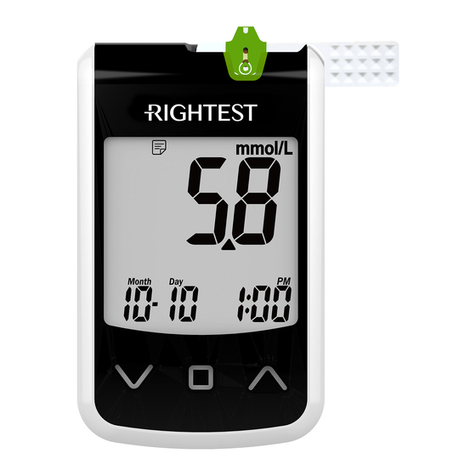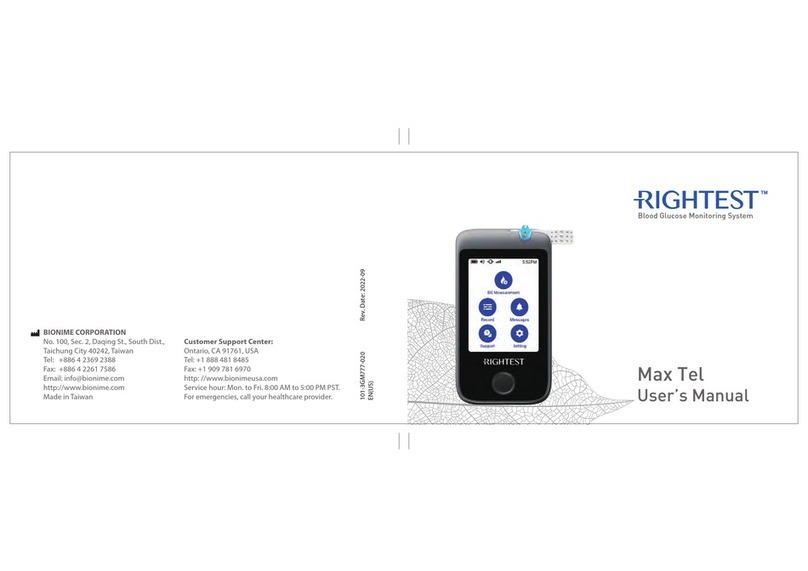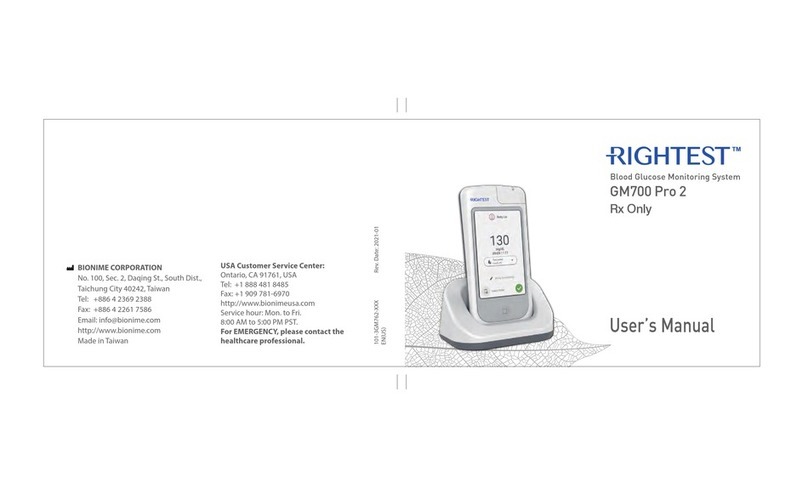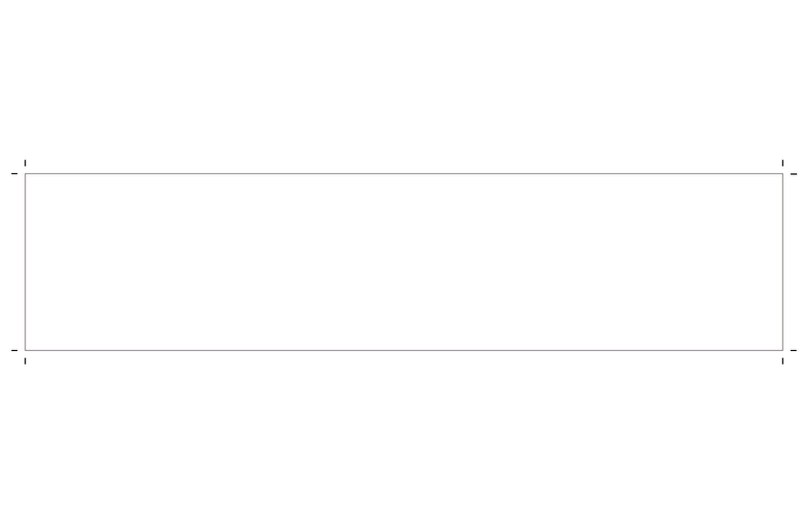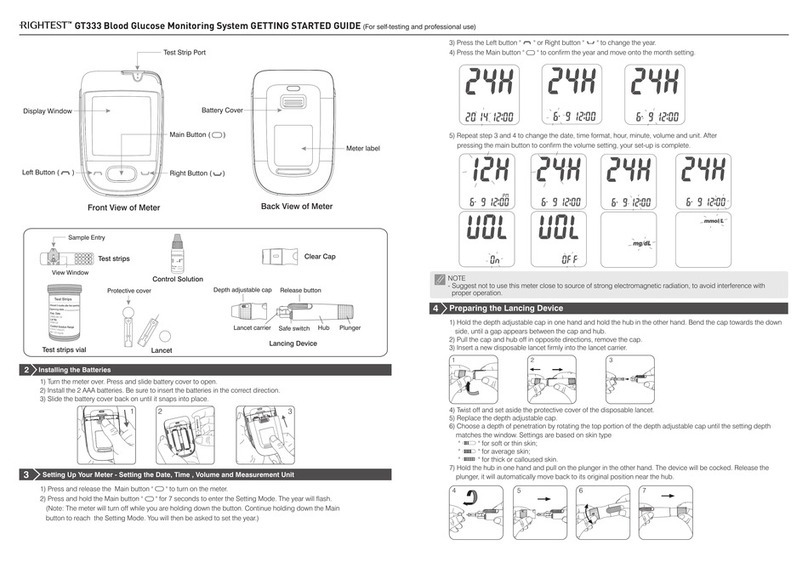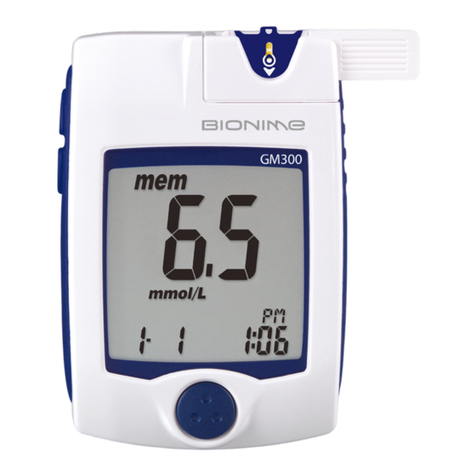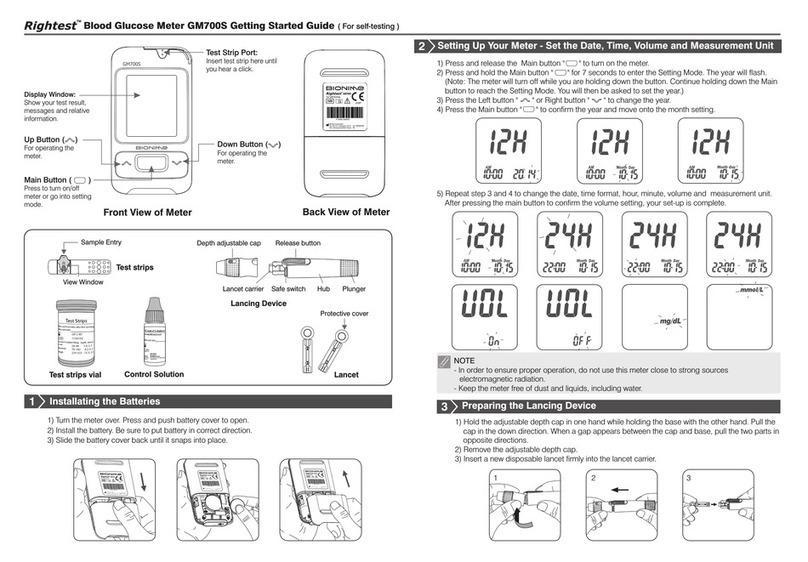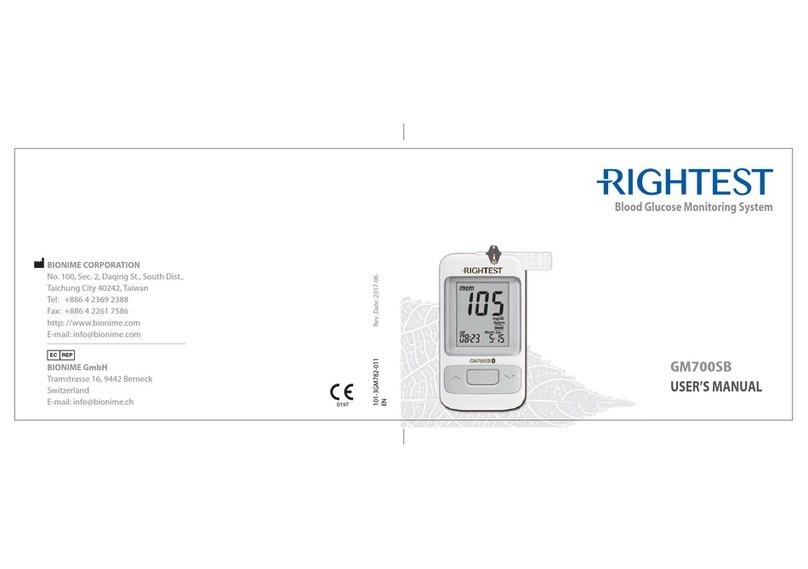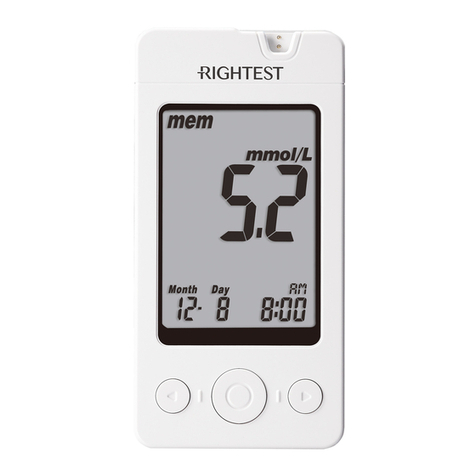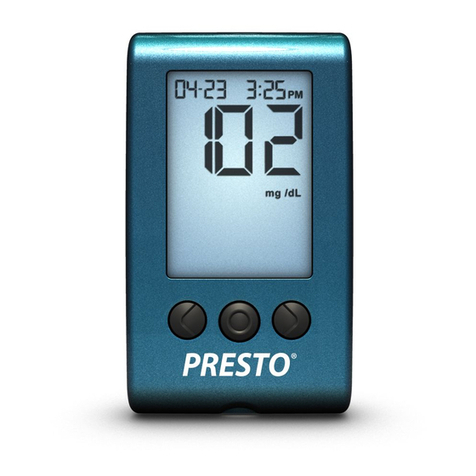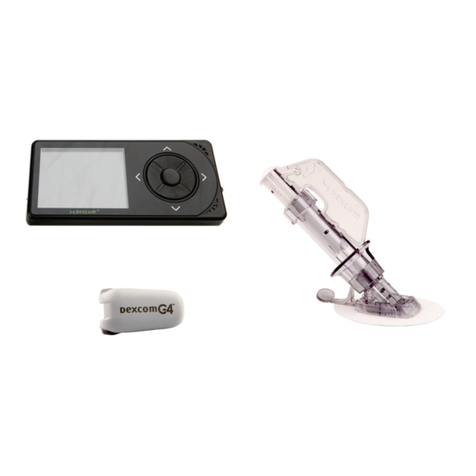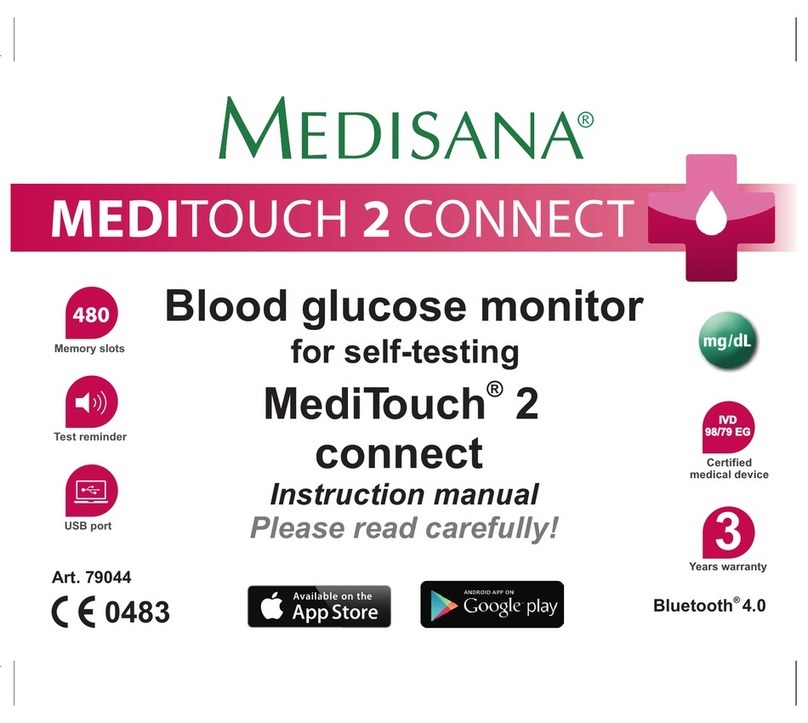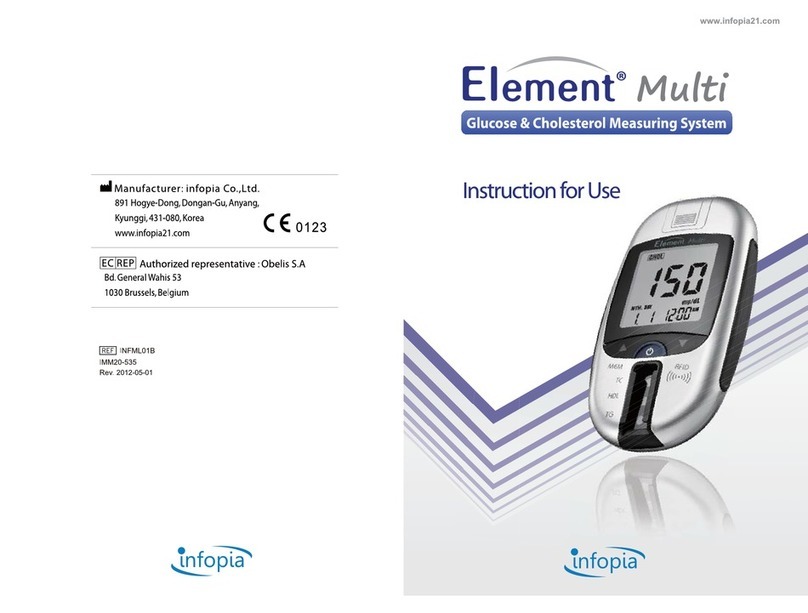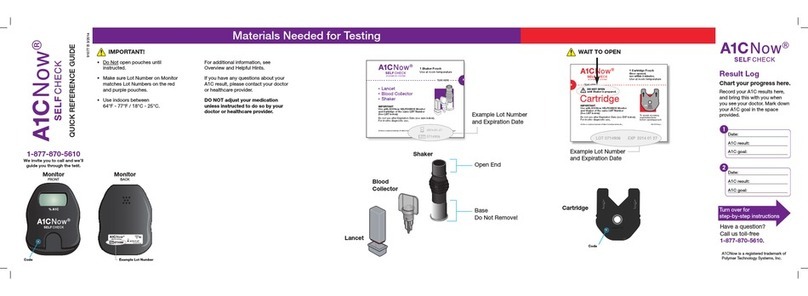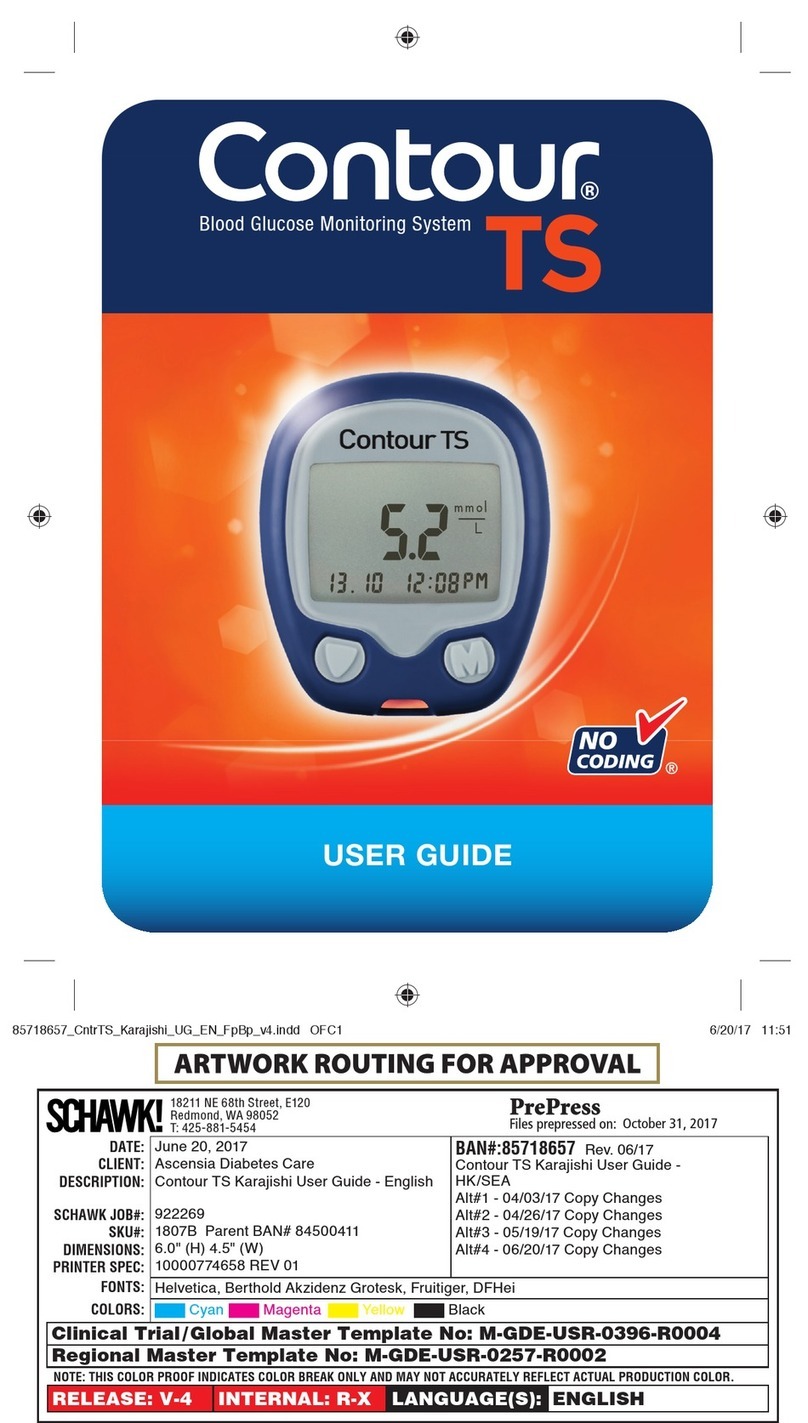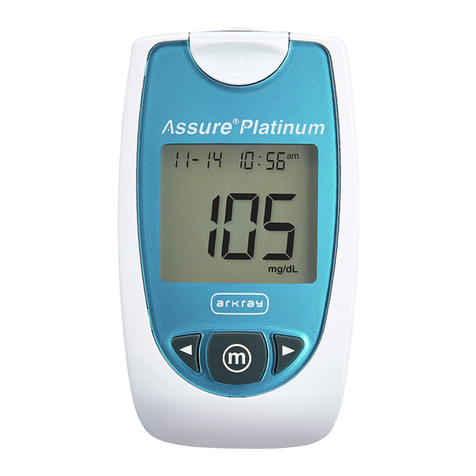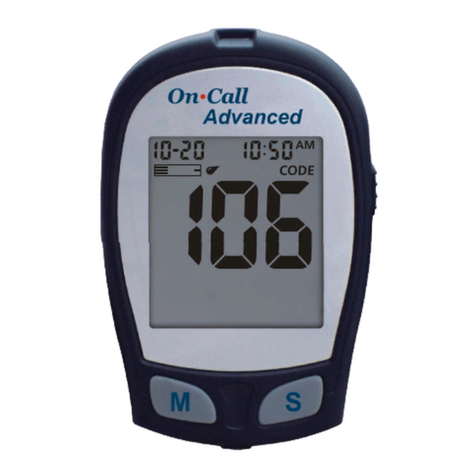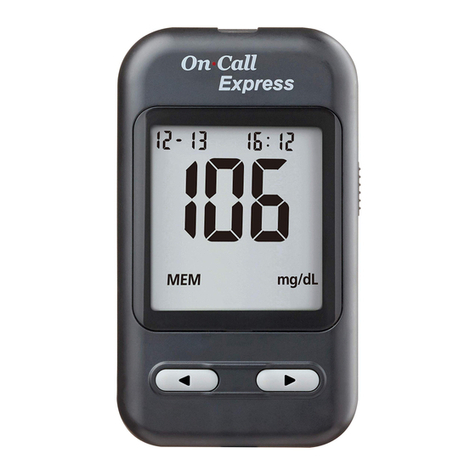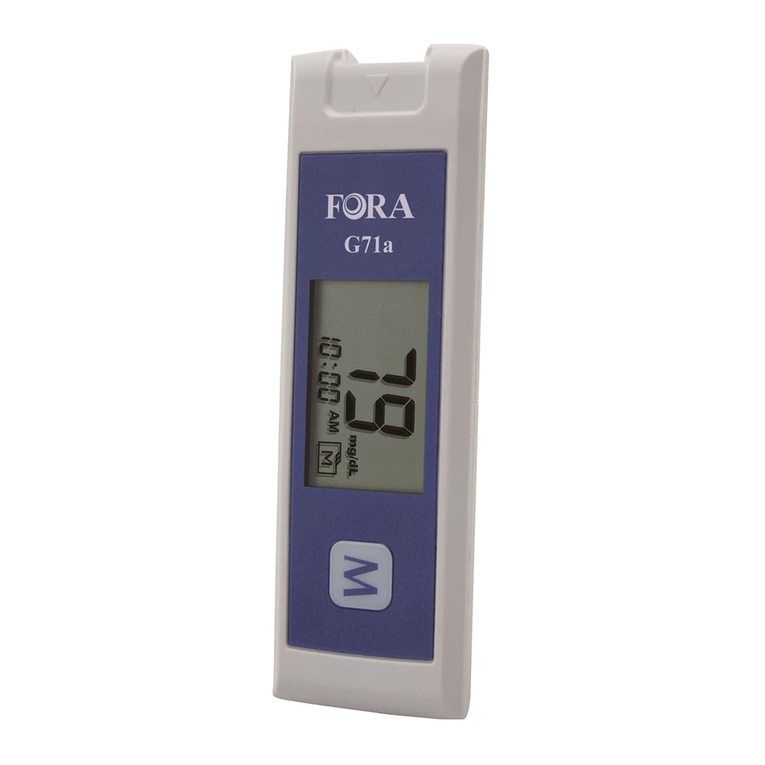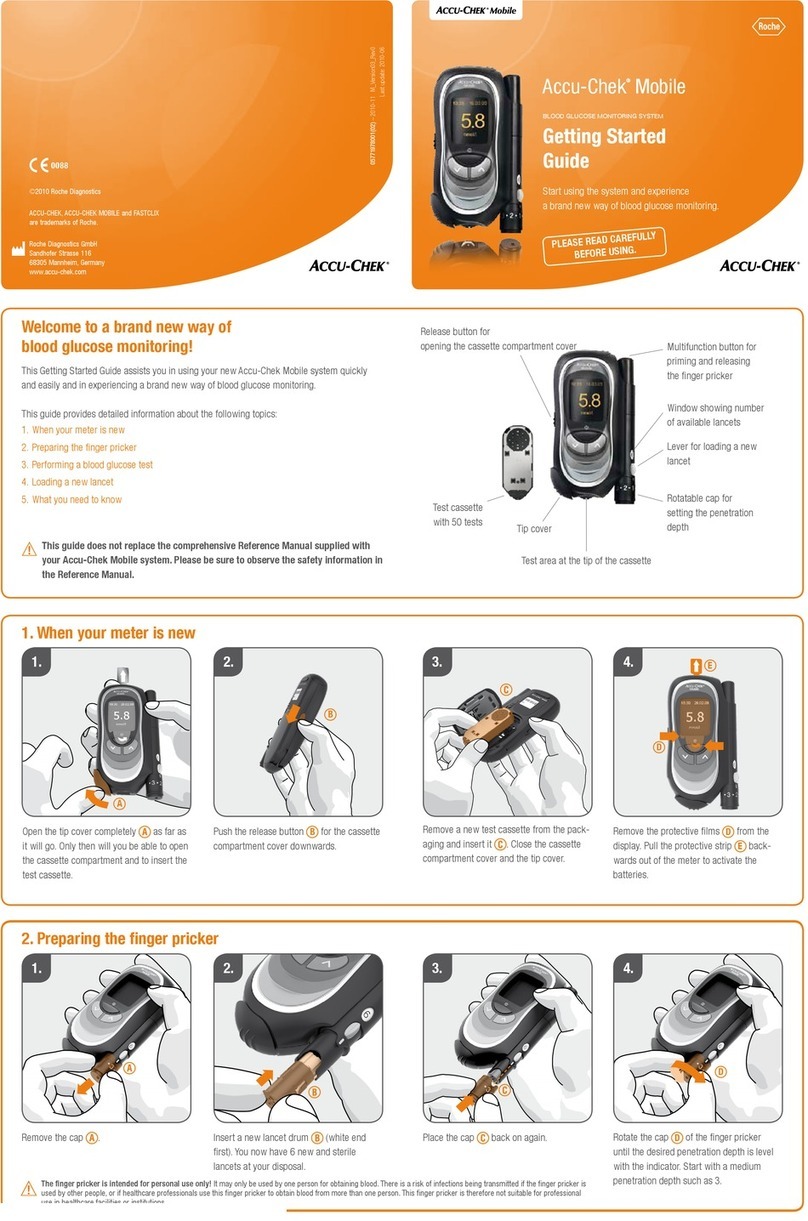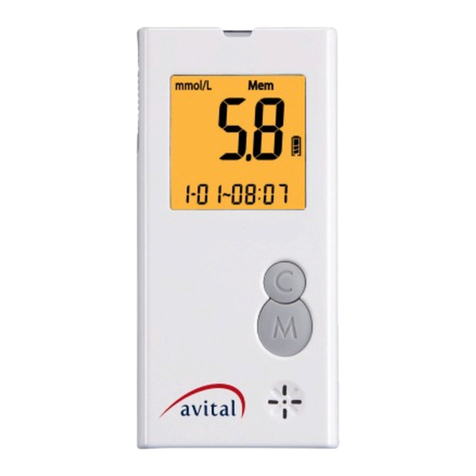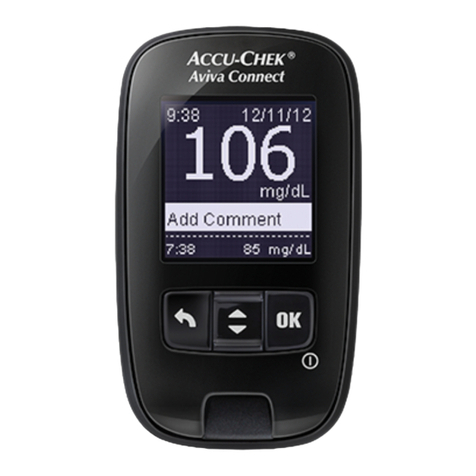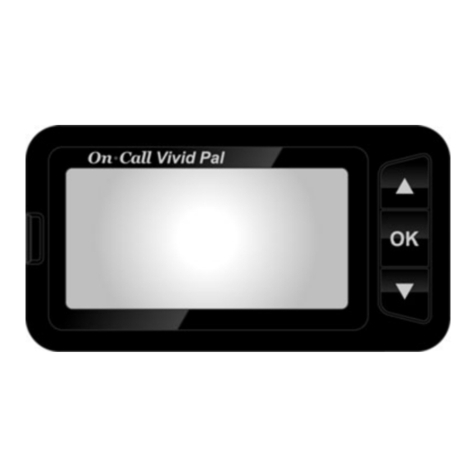
References
1) Diabetes Information - American Association for Clinical Chemistry (AACC)〔Electronic Version〕
Retrieved May 08, 2019 form www.labtestsonline.org/understanding/analytes/glucose/test.html
2) Review of Glucose Oxidases and Glucose Dehydrogenases: A Bird's Eye View of Glucose Sensing
Enzymes. J Diabetes Sci Technol 2011 Sep; 5(5): 1068–1076 (2011).
Accuracy
The accuracy of the test study of the RIGHTEST Max Plus was demonstrated by comparing whole blood
(plasma equivalent) glucose values on RIGHTEST Max Plus with plasma glucose values on a lab
instrument.
A total of 105 patients were enrolled. A trained healthcare professional collected blood samples (from the
fingertip, palm , forearm and vein) using RIGHTEST Max Plus. Then the blood samples were centrifuged
immediately after collection to obtain plasma.
Analyze the plasma by the lab instrument - YSI 2300.
101-3GS770-050
EN
BIONIME CORPORATION
No. 100, Sec. 2, Daqing St., South Dist.,
Taichung City 40242, Taiwan
Tel: +886 4 2369 2388 Fax:+886 4 2261 7586
Bionime GmbH
Tramstrasse 16
9442 Berneck
Switzerland
Additional Information for Healthcare Professionals
Troubleshooting and Customer Service
For more information on error messages and trouble shooting, please refer to the Error Messages and
Trouble Shooting section of Max / Max Plus User’s Manual.RIGHTEST
If you have any questions or in case of problems with the products Max / Max Plus, please RIGHTEST
Interferences
26 toxic amount tested substances (Acetaminophen, Ascorbic acid, Dopamine, EDTA, Gentisic acid, Heparin,
Ibuprofen, L-dopa, Methyldopa, Pralidoxime iodide, Salicylic Acid, Tetracycline, Tolazamide,
Tolbutamide, Bilirubin, Cholesterol, Creatinine, Glutathione, Haemoglobin, Triglycerides, Uric acid, Maltose,
Xylose, Galactose, Lactose, Icodextrin) in two blood sample concentrations.
Substance and possible level may interfere the glucose measurement:
Ascorbic acid ≧5 mg/dL (0.28 mmol/L)
Uric acid ≧16 mg/dL (0.95 mmol/L)
Xylose ≧16 mg/dL (1.07 mmol/L)
Glutathione ≧93 mg/dL (3.03 mmol/L)
Reagents
Each Blood Glucose Test Strip contains the following reagents:
1. FAD-Glucose dehydrogenase 12.4 %
2. Potassium Ferricyanide 49.6 %
3. Non-reactive Ingredients 38.0 %
Lay User Evaluation
A total of 105 users were enrolled. Each user tested their fingertip blood samples with 3 lots of Max strip and
Max Plus meter. Then the professional collected blood samples were centrifuged immediately after collection to
obtain plasma. Analyze the plasma by the lab instrument (YSI 2300 analyzer). 100% of the RIGHTEST Max
Plus BGMS values were within ±15% of YSI values at glucose concentrations ≧100 mg/dL (5.55 mmol/L) and
within±15 mg/dL (0.83 mmol/L) at glucose concentration <100 mg/dL (5.55 mmol/L)
(ii) Control solution:
P-01
300
45.3 (2.5)
1.7 (0.09)
3.8 %
P-02
300
94.3 (5.2)
1.9 (0.10)
2.0 %
P-03
300
133.4 (7.4)
3.1 (0.17)
2.3 %
(i) Venous whole blood sample:
Glucose levels
(1) Total test numbers (n)
(2) Mean mg/dL (mmol/L)
(3) SD mg/dL (mmol/L)
(4) CV (%)
Glucose levels
(1) Total test numbers (n)
(2) Mean mg/dL (mmol/L)
(3) SD mg/dL (mmol/L)
(4) CV (%)
P-04
300
197.6 (11.0)
2.8 (0.16)
1.4 %
P-05
300
296.2 (16.5)
4.7 (0.26)
1.6 %
CS-L
300
55.6 (3.1)
1.5 (0.08)
2.8 %
CS-H
300
267.0 (14.8)
4.1 (0.23)
1.6 %
Quality Control Section
Please refer to the Quality Control section of the User’s Manual.
Storage and Handling
- Store the strips in the original capped vial at temperatures between 4°C to 30°C (39°F to 86°F) and relative
humidity below 90%. Do not freeze.
- Close the vial cap immediately and tightly after taking test strip out from the vial. Do not leave the cap of
vial opened. If the strip is exposed to the air too long, it will absorb the moisture and cause wrong test
result.
- When you open a new vial of test strips please write the opening date on the label. Use test strips within
12 months after first opening or until the expiration date printed on the label (whichever comes first).
Measurement Range
The measurement range of RIGHTEST System is 10 to 600 mg/dL or 0.6 to 33.3 mmol/L.
NOTE
- Suggest not to use this meter close to source of strong electromagnetic radiation, to avoid
interference with proper operation.
- Suggest to keep meter free of dust, water or any liquid.
Difference range in values
between the YSI value and the
RIGHTEST Max Plus meter
value
Within± 5 mg/dL (0.28 mmol/L)
Within± 10 mg/dL (0.56 mmol/L)
Within± 15 mg/dL (0.83 mmol/L)
The percent ( and number ) of samples of alternative site were the
difference between the RIGHTEST Max Plus blood glucose meter and
the YSI value within the range shown in the side row.
Bias range in values
between the YSI value and
the RIGHTEST Max Plus
meter
Within ± 5 %
Within ± 10 %
Within ± 15 %
The percent ( and number ) of samples of alternative site were the bias
between the RIGHTEST Max blood glucose meter and the YSI Plus
value within the range shown in the side row.
Table 2 : represents samples for glucose concentrations ≧ 100 mg/dL (5.55 mmol/L).
Table 1 : represents samples for glucose concentrations < 100 mg/dL (5.55 mmol/L).
* Acceptance criteria in ISO 15197 : 2013 are that 95 % of all differences in glucose values should be
within±15 mg/dL (0.83 mmol/L) at glucose concentrations < 100 mg/dL (5.55 mmol/L), and within ± 15 %
at glucose concentrations ≧ 100 mg/dL (5.55 mmol/L).
Note: For glucose concentrations < 100 mg/dL (5.55 mmol/L), difference values are expressed in mg/dL
(mmol/L), and for glucose concentrations ≧ 100 mg/dL (5.55 mmol/L), difference values are compared
in percentage.
Fingertip
74.9 % (319/426)
99.5 % (424/426)
100.0 % (426/426)
Palm
70.0 % (298/426)
97.7 % (416/426)
100.0 % (426/426)
Forearm
71.1 % (303/426)
97.7 % (416/426)
100.0 % (426/426)
Fingertip
64.2 % (131/204)
99.5 % (203/204)
100.0 % (204/204)
Palm
65.7 % (134/204)
99.5 % (203/204)
100.0 % (204/204)
Forearm
68.1 % (139/204)
97.5 % (199/204)
100.0 % (204/204)
(2)
Detection Principle
The FAD-glucose dehydrogenase and potassium ferricyanide in the strip react with the glucose in the
sample to produce an electrical current which is proportional to the amount of glucose in the sample.
The meter measures the current and converts it to the corresponding glucose concentration.
Performance Characteristics
Data generated using RIGHTEST Max Plus Blood Glucose Meter. RIGHTEST Max plus Blood Glucose
Meter is the representative of the RIGHTEST Max Blood Glucose Meter family (included Max and Max
Plus Blood Glucose Meter).
Precision
The precision was evaluated including (i) 5 glucose levels of venous whole blood samples (blood
samples were collected with heparin tube and altered for test after 8 hours) (ii) 3 glucose levels of
control solution, in period of 10 days, by 10 meters and 3 batches of strips.
CS-N
300
117.4 (6.5)
2.5 (0.14)
2.2 %
Venous blood
54.3 % (140/258)
98.1 % (253/258)
100.0 % (258/258)
Venous blood
64.8 % (241/372)
96.8 % (360/372)
100.0 % (372/372)
- Storage of test strips near bleach or bleach containing products will affect the results of the RIGHTEST
Max Blood Glucose Test Strips.
- Max Blood Glucose Test Strips are designed for use with capillary, venous, arterial and RIGHTEST
neonatal whole blood samples. Do not use serum or plasma samples.
- Incorrect test results may be obtained at high altitude more than about 3,048 meters (10,000 feet)
above sea level.
- Venous, arterial, and neonatal blood testing is limited to healthcare professional use only.
- Severe dehydration and excessive water loss may cause inaccurately low results.
- Do not perform the blood glucose test at temperatures below 6°C (43°F) or above 44°C (111°F), below
10 % or above 90 % relative humidity.
For in vitro diagnostic use Manufacturer
IVD For single use only EC Representive
LOT
Lot number
CE-mark (with No. of notified body)
Consult the instruction for use
Store between tempe rature 4°C and 30°C ( 39°F a nd 86°F ) Biological risks Expiry date
Rev. Date:2019-05
Hematocrit(Hct)
Hematocrit(Hct) should be between 10% to 70%. If you do not know your hematocrit, ask your healthcare
professional.
